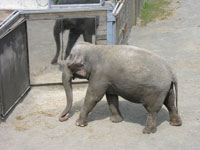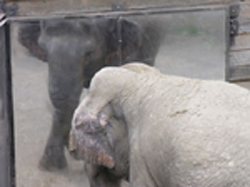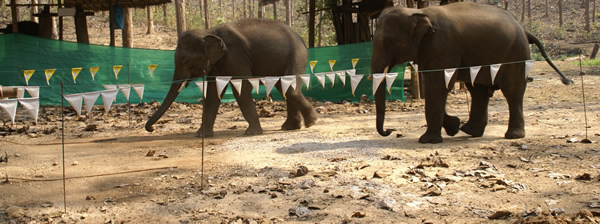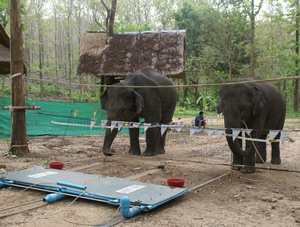Research
Cooperation
Elephants know when they need a helping trunk in a cooperative task
Unlike for chimpanzees, dogs, monkeys, parrots and crows, there has been remarkably little research on elephant cognition even though these animals are widely regarded as highly intelligent. A new study shows that elephants not only cooperate with friends, but also understand how cooperation works. In a study out this week in the Proceedings of the National Academy of Sciences U.S.A., a group of researchers from Emory University, in the U.S., and the Thai Elephant Conservation Center, in Thailand, worked with 12 Asian elephants at the Center to see whether or not they could learn to cooperate in pairs. The task required careful coordination so that each elephant could obtain a highly favored bucket of corn. When two elephants pulled two ends of the same rope, an out-of-reach table moved the corn close enough to be retrieved and eaten. However, if one end of rope was pulled before or without the other, the rope unthreaded from the table and the elephants got nothing.
“It's a great task originally designed for chimpanzees by a research group in Japan. It seems simple, but actually requires quite a bit of understanding,” said Josh Plotnik, the lead author on the study and now a postdoctoral fellow at the University of Cambridge in England. The elephants first learned to pull the table alone and then given an opportunity, now with a single rope threaded through and around the table, to pull with a partner. The elephants quickly learned to coordinate even if one elephant was released before the other, so that they needed to wait for the other to be successful. Plotnik: “We found that elephants would wait at their rope end as long as 45 seconds. They understood that pulling without the partner wouldn't earn any reward.”
In a different phase of the study it was found that elephants wouldn't pull the rope if their partner lacked access to the rope. They retreated back away from the table. This showed that the elephants not only knew they needed a partner, but also that their partners' behavior (pulling) mattered. Frans de Waal, another author on the study and Professor of Psychology at Emory University, said: “It is so hard and dangerous to work with elephants that there are almost no studies of their intelligence, such as those Josh has conducted in Thailand. We hardly knew what to expect. Would the animals pay attention to each other, and realize this is a cooperative task? But they did about as well as chimpanzees do in similar set-ups. No wonder, elephants are widely regarded as among the smartest animals.”
“In the wild, elephants are known for remarkable displays of helping, empathy and compassion. They are a very social animal, so this demonstration of complex cooperation fits well with what we know about their natural lives,” says Plotnik. He notes that many elephant organizations in Thailand are trying desperately to draw attention to the plight of the elephant, a species whose numbers in the wild are rapidly declining. Plotnik notes that there are probably less than 2,500 left in the Thai jungle. “As animal lovers,” he said, “we are interested in bringing greater attention to conservation causes, and elephants are a huge one.”
View Quicktime Movies
Video S1. This video was captured from the bird's-eye view video camera, and shows a trial in which Umpang (UP; bottom of the screen, left lane) and Khawd (KD; top of the screen, right lane) successfully pull in the table during a simultaneous release trial. The checkerboard patterns on the table were used for bird's-eye view video coding purposes only.
Video S2. This video shows a trial in which Wanalee (WL; bottom of the screen, left lane) and Jojo (JO; top of the screen, right lane) successfully pull in the table during a delayed release trial. In this trial, WL was released 29 sec before JO, and waits for JO's arrival before pulling.
Video S3. This video shows a delayed release trial (36 sec) in which Sri Sayam (SS; top of the screen, right lane) fails to wait for his partner, Kaew (KW; bottom of the screen, left lane) before pulling the rope. The retreat of Kaew's rope end is easiest to see right as he reaches to retrieve it from underneath the net.
Video S4. This video shows a control trial for Phrathida (PT) and Luuk Khang (LK). Note that after LK approaches (top of the screen, right lane), PT holds the rope without pulling (bottom of the screen, left lane). PT then retreats from the apparatus soon after LK does, without any prompting from the mahouts. Note that in these control trials, the partner's rope is coiled at the base of the table and thus is never available to the elephant. Late in the trial, LK will pull an innocuous rope attached to the tree (this rope was left within the elephant's reach by accident).
Video S5.
This video shows a trial in which Neua Un (NU) and Alina (AL) successfully pull in the table during a delayed release trial. Note the alternative strategy: NU uses her left front foot to hold her rope end in place, while AL uses her trunk to pull in the table.
This study was a collaboration between the following organizations:
- Living Links Center, Yerkes National Primate Research Center, Emory University, Atlanta, GA (Frans de Waal)
- Department of Psychology, Emory University, Atlanta, GA (Frans de Waal)
- Thai Elephant Conservation Center, Forest Industry Organization, Ministry of Natural Resources and Environment, Lampang 52000, Thailand (Richard Lair)
Mirror Self-Recognition
Asian elephants show evidence of mirror self-recognition

Elephants have joined a small, elite group of species, including humans, great apes and dolphins, that have the ability to recognize themselves in the mirror. This newly found presence of mirror self-recognition in elephants, previously predicted due to their well-known social complexity, is thought to relate to empathetic tendencies and the ability to distinguish oneself from others.
Researchers exposed three female elephants housed at the Bronx Zoo in New York to a jumbo-sized mirror measuring eight feet high by eight feet wide inside the elephants' yard. During the exposure, the elephants tested their mirrored images by making repetitive body movements and using the mirror to inspect themselves, such as by moving their trunks to inspect the insides of their mouths, a part of the body they usually cannot see. Further, the animals did not react socially to their images, as many animals do, and did not seem to mistake their reflection for that of another elephant.

As a result of this study, the elephant now joins a cognitive elite among animals commensurate with its well-known complex social life and high level of intelligence. Although elephants are far more distantly related to us than the great apes, they seem to have evolved similar social and cognitive capacities making complex social systems and intelligence part of this picture. These parallels between humans and elephants suggest a convergent cognitive evolution possibly related to complex sociality and cooperation.




